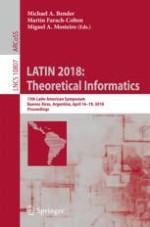This book constitutes the proceedings of the 13th Latin American Symposium on Theoretical Informatics, LATIN 2018, held in Buenos Aires, Argentina, in April 2018. The 63 papers presented in this volume were carefully reviewed and selected from 161 submissions. The Symposium is devoted to different areas in theoretical computer science, including, but not limited to: algorithms (approximation, online, randomized, algorithmic game theory, etc.), analytic combinatorics and analysis of algorithms, automata theory and formal languages, coding theory and data compression, combinatorial algorithms, combinatorial optimization, combinatorics and graph theory, complexity theory, computational algebra, computational biology, computational geometry, computational number theory, cryptology, databases and information retrieval, data structures, formal methods and security, Internet and the web, parallel and distributed computing, pattern matching, programming language theory, and random structures.
